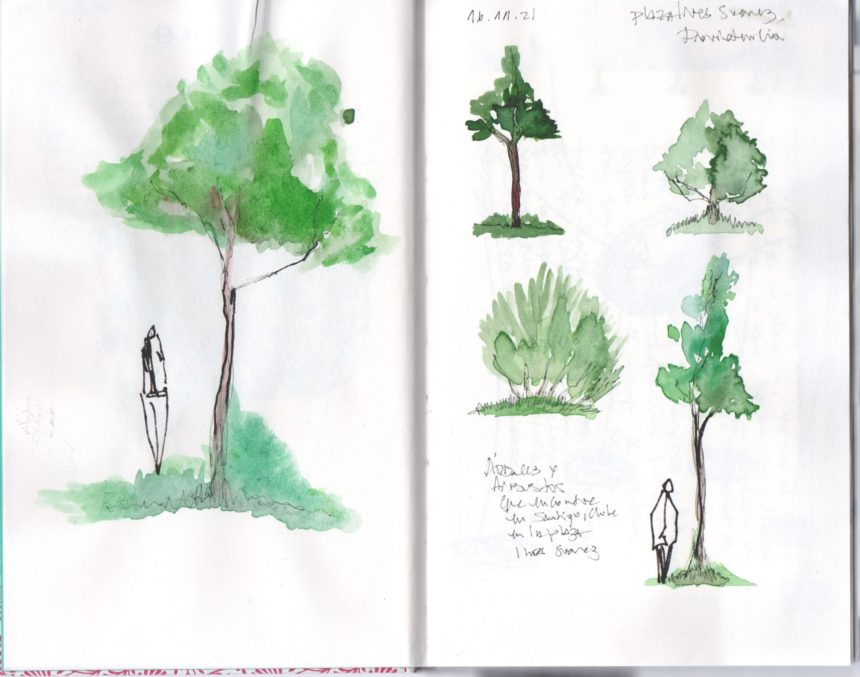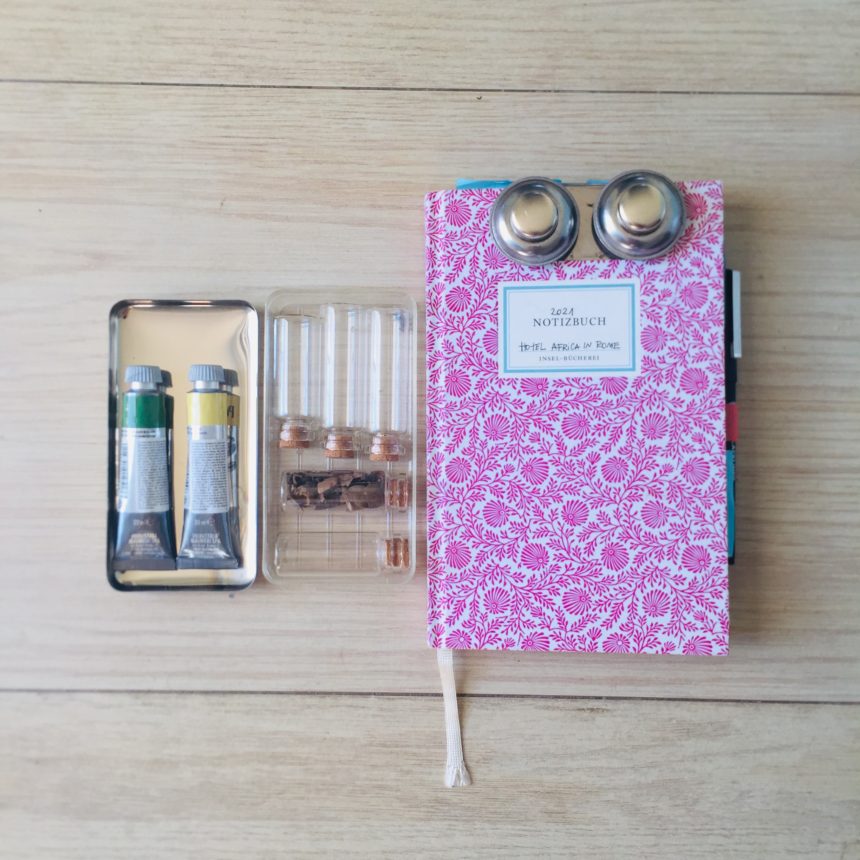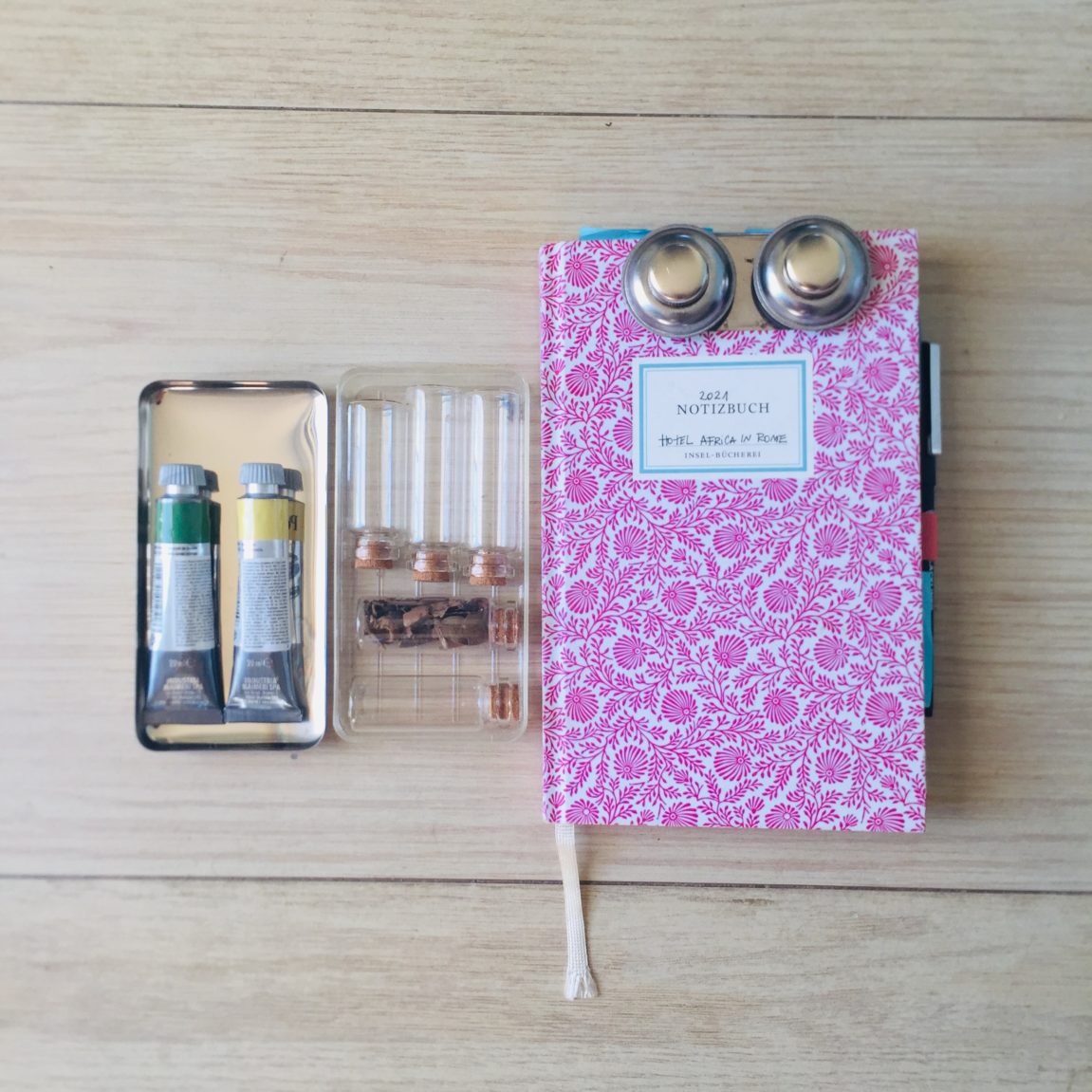Through an open letter to my fellow field inventors, I intend to share my inquiries between ethnographic methods and artistic practices to form new ideas in field devices. In the first part of this letter (see Part 1: How can sonority be a device for fieldwork?) I reflect on Sonority as a sound ethnographic experience and how sound might shape the path to/in the fieldwork. In this second part I consider the artist’s journal as a fieldwork diary, emphasizing new forms of narrative within the fieldwork diary as a descriptive, analytical and material-artistic device.
Dear field inventors,
I am writing this letter to continue with my ongoing reflections on my ethnographic and artistic methods experimentations in my fieldwork. Specifically in this second part I am interested in sharing with you my material and theoretical reflections between Artist’s diary, raw notes and field journal. In order to give you a better context of my practices and also my background I invite you to read the first part of this letter (see Part 1: How can sonority be a device for fieldwork?) which embraces Sound and Walking as a way to collect data and as an instrument to reflect on decolonial and postcolonial processes.
One of the artistic methods I use to archive, collect and capture my journeys and life processes as an artist has been the “famous” artist diaries. This type of diary is an art piece created whose concept implies that the work has to maintain some constellation and connection, which can be of ideas, forms, or materialities. It is a flexible, imprecise, and broad definition that helps create no conceptual, formal, or material limitations when it is made (Crespo, 2012). In the end, it is a space (abstract and material) where the pages of the “book” guide you in the chronology of the story you want to tell.

Back in my university years as an art student, our professors encouraged us to always have a “notebook/artist’s diary” at hand. As a sort of artifact that contained everyday experience, from writings, materials found on the street (like bus tickets, tree leaves, small garbage pieces, etc.), rapid drawings (sketches) of people and urban architecture, and ideas for art projects (many never started). This descriptive container of sensory and material ideas about the “surroundings” naturally led me to bring it into my fieldwork(s), merging it with the field journals that ethnographers use as a written container of observation. The use of raw notes within the ethnographic diary made me link it with the first raw inspiration that the Artist has to capture in an aesthetic way what has just been observed. The juxtaposition between artistic and analytical description inspired me to develop Artist’s diary as a field journal like a device for my fieldwork. This artifact interweaves written narratives about daily life in the field, ethnographic poetry, architectural drawings of the site, subjective cartographies, and attached organic and non-organic objects, accounting for everyday experiences and narrating in a sensory way through words, graphics, and materialities.
For example, I’m currently working on my second fieldwork diary in Los Arenales Macrocamp, Antofagasta, Chile. The production process within the journal is based on “capturing” the daily routine. Sometimes, I would write my raw notes in the diary after my day in the field — whatever I remembered happened—. Other times (on-site), I would write an ethnographic poem or draw the place & people, trying to describe what I am looking at at the moment. Between rhythmic words and synthesized lines of movement or architectural form, the place’s description and ambiance were expressed with a different kind of formality. In the area of Los Arenales Macrocamp, it was impossible to document with a camera. This camp is the only one of my three case studies within an active community. Compared to my previous cases in Italy and France, where only the “ruins” or “empty” places remained, the ethical challenges of photographing were different from those with people living. In Los Arenales Macrocamp, the dynamics were different; the camera was not welcome, not only because of the ethical questions of the camera as an intrusive medium but also because of the various internal dynamics of the surroundings. As reported by authorities and locals, the camp is located next to the hot-spot of criminalization and trafficking in Antofagasta, being an unclear border between the hot zone and the settlement itself — People’s anonymization is essential in the internal dynamics of the place. Here the rapid poems and sketches were another way of “capturing” the “framed image” richness in colors and matter I was observing.
Specifically, the production process of writing raw poetry starts with me sitting in a sector of the camp (where I could observe the landscape wider) and writing down words and short phrases as a sort of “checklist” of what I was observing. I would start by naming the tones and shades of the colors of the place (soils, vegetation, facades, etc.), then I would write down what kind of construction materials I observed in the housing structures and infrastructures. In addition, if I saw people passing by, I tried to note the colors and textures of the clothes they were wearing. Finally, I would finish with words that could describe the smells and noises of the place. Later on, I would elaborate on when I got home and often transformed into ethnographic poetry. In the case of the production of the raw drawings, the process was different; the “checklist” was replaced by rapid lines that tried to capture the movement (in the case of people) or the underlying structure (in the case of facades, trees or infrastructures). Instead of the checklist, where the idea was to be as detailed as possible, the drawing lines synthesized (like a scientific sketch) what I was visualizing, glancing for the guidelines so that the desired form would be “captured” on paper. Finally, my last approach to “capture” the place was from a physical aspect. While walking, I would take out my small empty glass jars and small zip lock bags as containers for the organic and non-organic materials I collected from the field, as a kind of archeological technique of taking a “sample” of the place. I collected soils, concrete materials, drinking water, vegetation, etc. Some materials were attached to the diary, and others were kept in a preservation box.

Learnings | reflections
Based on my experimentation using poetry, drawing, and the sample collection as instruments to try to “capture” the place contents in the field diary. I began my thoughts on how the gestures of sitting, observing and writing/drawing, or walking, observing, and collecting guided me in understanding these techniques as a kind of filter contributing to synthesizing the “real” situation. For example, the raw poem and drawing gave me the first filter for a preliminary field description due to its degree of precision and detail. My eyes became more analytical, searching for the perfect word or structural drawing line, focusing on specific points to be as precise as possible at the moment of the description, leaving apart the visual overwhelm left by fieldwork. I tried, by drawing, to reach the essence of the place-shape through its dimensions, movement, and forms, or across poetry, the effort to capture the atmosphere of emotion & place. Additionally, collecting “samples” of organic and non-organic materials makes me feel the site concretely, taking a piece of the place literally — transporting the materiality from “there” to “here.” The close observation of ethnographic poetry, (pseudo)scientific drawing, and sample collection allowed me to be more present in the here and now of the fieldwork, feeling that I really “was there” (Marquez, 2018:3) and not a hazy memory of my presence in the place.
HOW TO
I try not to overthink the result of what I was writing, drawing, or collecting, but instead, follow my instincts and intuitions as a field inventor and let myself be guided by the field. Nevertheless, I can give some tips that have helped me in my daily fieldwork. I suggest always having the diary with a pencil (or pencils) at hand. In my case, I stick them in the diary, so I don’t lose them and be ready when I have to write or draw. I consider the size of the diary to be significant. Not too small to have enough space to draw and adhere to sample materials. Not too big that it is easy to carry. My diaries, for example, are all 14 x 21 cm each, a size that fits in the big pocket of my “walking” jacket. Besides that, I have an obsession with the journal aesthetics; for me, all the diaries of my trips and fieldwork must be of the same format, design, and style. My “meta” is to publish them all one day and exhibit them together — however, everyone has their tastes and aesthetic obsessions, so this tip might not be so handy (see examples here). Finally, if you think of drawing and using watercolors or paints, I recommend you have a diary with a not-so-thin sheet and textured much better. You will appreciate it when you are in the field and appreciate the paper resistance.
SOURCES
Forensic Architecture (FA) research agency. Goldsmiths: University of London. https://forensic-architecture.org/about/agency
Marquez, F (2018). Observar, dibujar y comprender: Reflexiones desde la etnografía. Coloquio: Línea y Lugar. Pensar en las prácticas del dibujo. Santiago: DIBAM – Museo de Bellas Artes – Universidad Alberto Hurtado. http://www.mnba.cl/617/articles-65217_archivo_01.pdf

